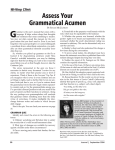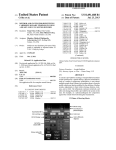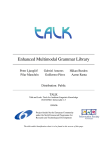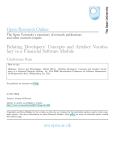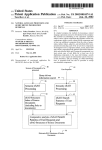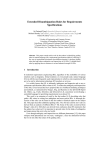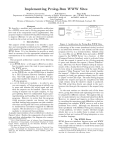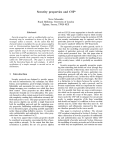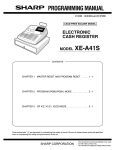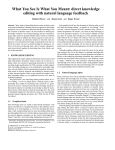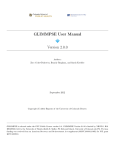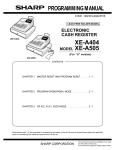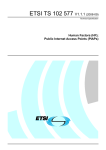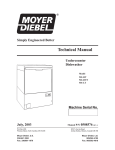Download Computer implemented method for reformatting logically complex
Transcript
l|||||||||||||ll||||||||||||||||||||||||||||||||||||||||||||||||||||||||||||||||||||||||||
US 20020129066A1
(19) United States
(12) Patent Application Publication (10) Pub. No.: US 2002/0129066 A1
Milward et al.
(54)
(43) Pub. Date:
COMPUTER IMPLEMENTED METHOD FOR
(52)
Sep. 12, 2002
US. Cl. ............................................................ .. 707/523
REFORMATTING LOGICALLY COMPLEX
CLAUSES IN AN ELECTRONIC
TEXT-BASED DOCUMENT
(57)
(76) Inventors: David R. MilWard, Cambridge (GB);
Robert G. Corbin, Chippenham (GB);
Stephen G. Pulman, ThriploW (GB)
ABSTRACT
A method of reformatting logically complex clauses, in
particular for enabling detection and correction of potential
ambiguity in legal documents, is disclosed. The method
comprises four distinct stages. Firstly, a passage of text is
analysed into its constituent_ parts of speech. Next, groups of
Words that belong together in large phrases are concentrated
Correspondence Address:
David L_ M ccombs
Haynes and Boone’ LLP
into larger units using linguistic rules. Thirdly, further lin
Suite 3100
guistic patterns take account of the grouping of these con
901 Main Street
catenated
phraises artild pickhout occurrences of ~logicgqltllye
1mportantWor s or p rases t at represent con]unct1ons.
Dallas’ TX 75202 (Us)
disclosed method uses rules to determine Whether the iden
(21) APPL NO;
(22) Filed;
09/752’845
ti?ed conjunctions are top level, i.e. logically signi?cant, or
Dec_ 28, 2000
Whether they are subordinate, i.e. link smaller phrases in the
text. In the ?nal stage, the annotated grammatical and logical
Publication Classi?cation
formation is used to display the original text in such a Way
that the logical structure is revealed. The method is suitably
computer-implemented through a softWare routine operable
(51)
Int. Cl.7 ................................................... .. G06F 15/00
1% TOMNISCD
upon text in a Word processing package.
Patent Application Publication
Sep. 12, 2002 Sheet 1 0f 5
US 2002/0129066 A1
Patent Application Publication
Sep. 12, 2002 Sheet 2 0f 5
US 2002/0129066 A1
Patent Application Publication
Sep. 12, 2002 Sheet 3 0f 5
US 2002/0129066 A1
{00
Patent Application Publication
A’
Sep. 12, 2002 Sheet 4 0f 5
US 2002/0129066 A1
w, Tom-M560
fmmnf f’) FA?!“
0 (11/01
24 O
Patent Application Publication
Sep. 12, 2002 Sheet 5 0f 5
US 2002/0129066 A1
STHKT.‘
uwveqa‘La-m Sew
N300
'
Sep. 12, 2002
US 2002/0129066 A1
COMPUTER IMPLEMENTED METHOD FOR
REFORMATTING LOGICALLY COMPLEX
CLAUSES IN AN ELECTRONIC TEXT-BASED
DOCUMENT
FIELD OF THE INVENTION
[0001] This invention relates to a method for reformatting
logically complex clauses so as to clarify and to disambigu
ate them, and to an implementation of such a method by
those scanned in from typed versions) are only formatted by
paragraph.
[0015]
Various form of text analysis are built into current
Word processing packages. In their most basic form, these
alloW simple text string matching. Microsoft® Word(TM)
alloWs for simple grammatical checking of documents.
These do not and cannot, hoWever, analyse lengthy and
complex sentences. Various attempts have been made to
address Whole sentence analysis using full syntactic and
computer.
semantic analysis, and a brief discussion of this has been
BACKGROUND OF THE INVENTION
[0002] Many forms of legal or technical documents con
tain long sentences Which make reference to many condi
tions, alternatives or exclusions. These long and grammati
cally complex sentences can be dif?cult to understand, or
easy to misunderstand. In the case of such documents,
misunderstandings can lead to expensive errors being made.
The source of errors lies typically in the fact that these
sentences relate several different propositions to each other
using logical or causal relations. Because of the length of the
sentences, and their syntactic and semantic complexity, it is
easy inadvertently to create situations reminiscent of What is
knoWn in computer programming language terms as the
“dangling else” problem: given a nested conditional of the
form:
[0003]
cessing packages. Often, existing documents (particularly
if P then if Q then R else S
provided in the paper by R. Corbin, entitled “Using NLP to
check Contract Documentation”, presented at “Natural Lan
guage Processing: Extracting Information for Business
Needs” and published in the conference proceedings in
1997. To date, the use of full syntactic and semantic analysis
has proved to be of limited accuracy and in any case requires
signi?cant processing capabilities When implemented on a
computer.
SUMMARY OF THE INVENTION
[0016] The present invention provides an improved tech
nique suitable for implementation on a computer Which
alloWs rapid analysis and automatic reformatting of a pas
sage of text. According to the present invention, there is
provided a method of analysing and reformatting a passage
of text, comprising the steps of: (a) identifying Words in the
passage of text representing different parts of speech; (b)
[0004] It is impossible to determine Whether the “else”
grouping at least some of the identi?ed Words into discrete
units representing discrete linguistic phrases, so as to gen
condition is associated With the conditional clause “if P . . .
erate a partially analysed text passage; (c) identifying logi
” or the conditional clause “if Q . . . ”. The tWo situations are
cally signi?cant conjunctions Within the said partially analy
of course logically distinct: if the else condition is associated
sed text passage; and (d) reformatting the passage of text that
With “if P . . . ” then S Will be the case Whenever P is not true,
has been analysed so as to reveal the logical structure
thereof.
regardless of the state of Q and R. HoWever, if the else
condition is associated With “if Q . . . ”, then S Will only be
the case if P is true but Q is not.
[0017] Identifying logically signi?cant conjunctions after
[0005] In modern electronic documents, Word processing
programs alloW a good, unambiguous style to be adopted
?rst carrying out a partial, incomplete syntactic and seman
tic analysis alloWs automatic reformatting of passages of
text (such as complex sentences) in a particularly ef?cient
manner. Searching for patterns in the output of a partial
With relative ease. A sentence drafter may break up a
sentence, using for example bullet points or indentation to
separate out the different components and shoW hoW they are
related. To return to the example above, it may be Written as:
[0006] if P then
[0007] if Q then R
[0008] else S
[0009]
Indicating that the else condition is associated With
analysis has proved, surprisingly, reasonably robust With
respect to inaccurate or incomplete analysis of the “raW”
passage of text. The bene?ts in analysis of lengthy docu
ments such as contracts for example are manifest, alloWing
complex legal sentences to be displayed in a manner that
alloWs for the detection and correction of potential ambigu
ity.
[0018] This in turn reduces the risk of potentially costly
interpretation errors.
“if Q . . . ”. By instead formatting the sentence as
[0019]
[0010] if P then
[0011] if Q then R
[0012] else S
[0013]
It is visually indicated that the else condition is
associated instead With the condition “if P . . . ”. In other
Words, proper formatting alloWs the dangling else problem
to be resolved visually.
The method is preferably implemented as a soft
Ware routine for use on a personal computer. For example,
a passage or passages of Word processed text can be
exported to the softWare application, for analysis in accor
dance With the invention, and then returned to the Word
processor for display in the reformatted form.
[0020] The different parts of speech may be identi?ed
from the passage of text to be analysed by use of a statistical
technique such as Hidden Markov Modelling. The step of
identifying the parts of speech may involve labelling Words
[0014] Unfortunately, many drafters do not take advantage
With a tag indicative of the particular identi?ed part of
of the formatting features available in modern Word pro
speech.
Sep. 12, 2002
US 2002/0129066 A1
[0021] Preferably, the method further comprises grouping
at least some of the Words in the passage into a ?rst set of
intermediate phrases on the basis of a predetermined set of
linguistic rules. For example, a Word identi?ed as a de?nite
article such as “the” may be grouped With a noun (“con
tractor”) and an adjective (“?rst”) to generate a noun phrase.
Such a phrase may be tagged or labelled as such.
[0022] Most preferably, a recursive analysis, still based
upon a set of linguistic rules, may be employed to conjoin
the ?rst phrases into a second set of ?nal phrases. For
example, noun phrases may be combined With prepositional
[0030] FIG. 2 is a highly schematic diagram of a part of
the architecture of the personal computer of FIG.
[0031] FIG. 3 is a How diagram of the ?rst stage in the
processing of electronic text according to the invention;
[0032] FIG. 4 is a How diagram of the second stage of the
processing of electronic text according to the invention; and
[0033] FIG. 5 is a How diagram of the third stage in the
processing of electronic text according to the invention.
DETAILED DESCRIPTION OF THE
PREFERRED EMBODIMENT
phrases to generate larger phrases. The recursive analysis
may be carried out by repeatedly applying a ?nite state
analysis until, in accordance With the linguistic rules, no
[0034] The technique of the invention is preferably imple
further “phrase building” is possible.
[0023] Preferably, the step of identifying conjunctions
comprises searching for predetermined patterns of phrases
example, a personal computer 10. A suitable arrangement is
shoWn in FIG. 1. Text to be reformatted is initially displayed
from the second set of ?nal phrases constituting the partially
analysed text passage.
[0024] In a particularly preferred embodiment, the method
further comprises after the said step of identifying logically
signi?cant conjunctions in the partially analysed text pas
sage, the steps of identifying a grammatically appropriate
location for inserting of a second part of a tWo part con
junction Within the passage of text to be analysed, When such
second part of the said conjunction is not already present;
and automatically inserting at the identi?ed location, an
indicator into the reformatted passage of text When the text
is displayed, the said indicator indicating that the said
second part of the conjunction should be present there.
[0025]
There are many forms of tWo part conjunction,
such as “If. . . , then . . . ”; “Both . . . , and. . . ” and so forth.
The second part (usually a Word such as ‘then’, but also
potentially just a comma) is sometimes omitted from the
original text to be analysed. Inserting an indicator such as an
arroW, can thus be helpful in improving clarity and reducing
ambiguity.
mented as a computer sub-routine for operation on, for
upon a screen 15 of the personal computer 10, in a form
de?ned by the parameters of a Word processing package
such as Microsoft® Word(TM). This format, although con
taining formatting information from the Word processor
itself, contains natural ?ne breaks and so forth and is not set
out in a manner Which might reveal the logical structure of
the text.
[0035] The algorithm of the invention is preferably called
as a sub-routine from the Word processing package. Typi
cally this Will reside in a memory 20 of the personal
computer obtained from a storage device 25 such as a disk
drive (FIG. 2) and program steps Will be executed under the
control of a processor 30.
[0036] In a particularly preferred embodiment, the sub
routine is Written using the Prolog language Which Will be
Well knoWn to those of ordinary skill. The sub-routine is
called from Within Word(TM) by a Microsoft® Visual
Basic(TM) Script and Will likeWise reside in memory 20.
[0037] The Prolog program ?rst receives a copy 40 of the
text to be reformatted from the Word processing package.
This is achieved either by highlighting a section of text in the
[0026] The invention also extends to a computer program
having a plurality of program elements, the program, When
executed on a personal computer, being arranged to carry out
Word processing package to be reformatted, or by selecting
the method set out above. In that case, the program may be
arranged to receive the passage of text in either unformatted
processing program. In this manner, a full document may be
analysed, or just a single sentence.
ASCII form, or partially formatted (that is, still containing
information necessary for a Word processing program to
reformat the text in accordance With the invention) prior to
analysis, and further arranged to output the reformatted
passage of text also in either unformatted ASCII or, more
suitably, as partially formatted text, after analysis, for receipt
by a Word processing program.
[0027] In yet a further aspect of the invention, there is
provided a computer readable medium upon Which is
recorded the aforementioned program.
BRIEF DESCRIPTION OF THE DRAWINGS
[0028]
The invention may be put into practice in a number
of Ways, one of Which Will noW be described by Way of
example only and With reference to the accompanying
draWings, in Which:
[0029] FIG. 1 is a schematic diagram of a personal
computer having a screen displaying text both before and
after application of the method of the invention;
a menu option Within the Word processing program to
reformat the entire document currently open in that Word
[0038] In brief, the Prolog sub-routine takes the copy 40 of
the text from the Word(TM) Word processing program, carries
out the stages of analysis outlined beloW, and produces an
output ?le 50 in Which the text and the formatting informa
tion (introduced as a result of the linguistic analysis) is also
represented in a form capable of being displayed and edited
Within Word(TM) as is shoWn in FIGS. 1 and 2. Typically
this involves the generation of an output formatting instruc
tion set.
[0039] The resultant text output may be sent for display by
the screen 15 of the personal computer 10 (see FIG. 1)
and/or may be stored in storage device 25 (FIG. 2).
[0040] The procedure Will noW be described in more
detail, referring to the How charts of FIGS. 3-5.
[0041] Tokenising
[0042] The ?rst step is for the Prolog sub-routine to
“tokenise” the text received from the Word(TM) Word pro
Sep. 12, 2002
US 2002/0129066 A1
cessing program. This turns the Word ?le (or a stripped
doWn version thereof) into a ?le in a format containing
Prolog terms representing sentences. All information is
preserved at this stage. The tokeniser routine is con?gurable
so as to treat various special characters as required, to
recogniZe abbreviations, and so forth.
[0043] As an example, a typical text ?le as received by the
Prolog sub-routine at step 100 of FIG. 3 may be:
[0044]
Example 1, raW text
there may be no clear statistical difference betWeen the tWo
possibilities (plural noun or singular third person verb), and
in this case the choice made by the program is determined
on the basis of Which annotation Within the training corpus
is encountered the most frequently overall.
[0053] The principles of statistical analysis such as Hidden
Markov Modelling are further described in, for example,
James Allen, “Natural Language Understanding” 2nd edi
tion, Benjamin/Cummings Publishing Co. Inc., 1995,
[0045] If the Contractor shall neglect to execute the Works
With due diligence and expedition, or shall refuse or neglect
to comply With any reasonable orders given to him in Writing
by the Engineer in connection With the Works, or shall
contravene the provisions of the Contract, the ?rst afore
betWeen pages 195 and 204.
mentioned purchaser may give seven days’ notice in Writing
[0055] Example 1, tagged form
to the Contractor to make good the failure, neglect or
contravention complained of.
[0046] At step 110, the Prolog tokeniser turns this into a
?le Which looks like:
[0047] Example 1, tokenised text
[0048] sentence ([‘If, the, ‘Contractor‘, shall, neglect, to,
execute, the, ‘Works‘, With, due, diligence, and, expe
dition, ‘,‘, or, shall, refuse,or, neglect, to, comply, With,
any, reasonable, orders, given, him, in, Writing, by, the,
‘Engineer‘, in, connection, With, the, ‘Works‘, ‘,‘, or,
shall, contravene, the, provisions, of, the, ‘Contract‘, ‘,‘,
the, ‘Purchaser‘, may, give, seven, days, ““, notice, in,
Writing, to, the, ‘Contractor‘, to, make, good, the, fail
[0054] The passage of text, analysed according to its parts
of speech, and tagged, Will then appear as folloWs:
[0056] (‘If‘/in, the/dt, ‘Contractor‘/nn, shall/md, neglect/
vb. to/to, executr/vb, the/dt, ‘Works‘/nns, With/in, due/jj,
diligence/nn, and/cc, expedition/nn, ‘,‘/‘,‘, or/cc, shall/
md, refuse/vb, or/cc, neglect/vb, to/to, comply/vb,
With/in, any/dt, reasonable/jj, orders/nns, given/vbn,
him/prp, in/in, Writing/nn, by/in, the/dt, ‘Engineer‘/nn,
in/in, connection/nn, With/in, the/dt, ‘Works‘/nns, ‘,‘/‘,‘,
or/cc, shall/md, contravene/vb, the/dt, provision/nns,
or/in, the/dt, ‘Contract‘/nn, ‘,‘/‘,‘, the/dt, ‘Purchaser‘/nn,
may/md, give/vb, seven/cd, days/nns, ““/‘"‘, notice/nn,
in/in, Writing/nn, to/to, the/dt, ‘Contractor‘/nn, to/to,
make/vb, good/jj, the/dt, failure/nn, ‘,‘/‘,‘, neglect/nn,
‘,‘/‘,‘, or/cc, contravention/nn, complained/vbn, of/in,
ure, ‘,‘, neglect, ‘,‘, or, contravention, complained, or,
1,11)'
[0049] The Prolog sub-routine next splits the received text
into paragraphs (step 120) and then removes line break
information (step 130). The resulting tokenised ?le is used
for the second stage of the process.
[0050] Tagging
[0051] The next task carried out by the Prolog sub-routine
is to analyse the passage (in this example, a sentence) into
its most likely sequence of “parts of speech”, and this is
shoWn at step 200 in FIG. 4. That is, each Word in the
sentence is analysed to determine Which grammatical label
[0057] Where: /in is a tag indicating a preposition or
subordinate conjunction; /dt is a tag indicating a determiner
Word (“the” or “a”, for example); /nn indicates a singular
noun’ /md indicates a modal verb; /vb indicates a verb; /to
indicates an in?nitive marker for a verb; /nns is a plural
noun; /jj indicates an adjective; /cc is a coordinating con
junction; /vbn is a past participle; /prp is a personal pronoun;
and /cd is a cardinal number.
[0058]
It Will be understood that the results of the tagging
analysis Will depend upon the training corpus (i.e. the
“noun”, “verb”, “adjective” etc.) is most appropriate. Once
statistical basis) employed.
the program has decided on the most appropriate grammati
cal label for a particular Word, it is labelled With a tag (step
[0059] Phrasal Analysis
210).
[0052] In the preferred embodiment, a statistical technique
[0060] The next stage carried out by the Prolog sub
routine is to group Words that belong together, grammati
knoWn as Hidden Markov Modelling is employed to make
cally, into larger phrases and then label these larger phrases
this decision. The technique uses a corpus of sentences in
appropriately. This is carried out using linguistic rules. The
Which each Word has been annotated With the correct part of
speech, in order to train a statistical model of the likelihood
that one part of speech Will be found folloWing another. The
Words as possible have been incorporated into phrases. Then
purpose of a statistical analysis is to attempt to remove
aim is to try to build phrases ‘bottom up’ until as many
any remaining logical Words (‘and’, ‘or’, ‘if’, etc.) Will
ambiguities When Words are spelled identically but have
different meanings or indeed different grammatical senses,
depending upon the contexts. For example, the Word “asso
probably be associated With the high level logical structure
ciates” can be either a plural noun, as in “the company’s
associates”, or a third person singular verb, as in “We knoW
cannot distinguish betWeen different uses of Words like ‘and’
he associates”. The statistical analysis can determine the
most likely grammatical label from the context. In some
cases, as With, for example, “the company associates With”,
of the sentence, and can be recognised as such by the next
stage of analysis (see beloW). Notice that the tagging process
and ‘or’: it is only able to say that they are conjunctions,
since the tagging process only looks at Words in the context
of the preceding one or tWo Words. This process Will noW be
described in detail, referring to FIG. 4 once more.
Sep. 12, 2002
US 2002/0129066 A1
[0061]
Phrases are recognised both by ?nite state
machines (FSMs), and also by patterns. Examples of ?nite
state machines for recognising Noun Phrases and Verb
Groups (represented as regular expressions Which are com
piled to FSMs for actual processing) are:
[0063] This expression says that a Noun Phrase may
optionally begin With a determiner (the, a, etc.), or a pos
[0074] Example 1, higher level parsed form
[0075] [‘If’/in, [the/dt, ‘Contractor’/nn]/np,
[0076] [[bdhall/md, neglect/vb]/vg, [to/to, execute/
vb]/vg, [the/dt, ‘Works’/nns]/np,
[0077] [With/in, [sue/jj, [diligence/nn, and/cc,
expedition/nn]n/np]/pp,
[0078] [[shall/md, [refuse/vb, or/cc, neglect/vb]/
vb, [to/to, comply/vb]/vg]/vg,
sessive pronoun (his, her, . . . ), or a number (2, three, . . .
), optionally folloWed by either a singular or a plural noun,
ending With a singular noun. Some of the Noun phrases
[0079] [With/in, [any/dt, reasonable/jj, orders/nns]/
HUI/PP,
[0080] given/vbn]/vg, [him/prp]/np, [in/in, [Writ
ing/Ilnl/Ilpl/pp,
recognised by this expression include: ‘the plan; his Work
plan; three stage plan’, etc.
[0065]
This expression says that a Verb Group may consist
of a modal auxiliary (can, may etc.) optionally folloWed by
an adverb, folloWed by a verb in the in?nitive form, fol
loWed by a verb in the -ing form: eg ‘ . . . may(soon)be
completing . . . ’. This step is shoWn in FIG. 4 at 220.
[0066] An example of a pattern is:
[0068] Where [NP1/np,of/in,NP2/np] is the input and
[[NP1/np,of/in,NP2/np]/np] is the output.
[0069]
[0084] [[seven/cd, days/nns]/np, ““/““m [notice/
nnl/Ilpl/np,
This pattern says that When a sequence of tWo
Noun Phrases separated by an ‘of ’ is present, these are to be
grouped together as a single Noun Phrase, as in ‘[[the
operator] of [the machinery]]’. There are similar patterns for
recognising complex Verb Groups, Prepositional Phrases,
conjunctions of various types of phrase, and so forth. This
step is shoWn at 240 in FIG. 4.
[0070] The patterns and ?nite state machines are applied
in a predetermined sequence Which is typically determined
using trial and error. Firstly, ?nite state machines are applied
to look for a feW idioms, simple conjunctions, and noun and
verb groups (steps 220 and 230):
[0071] Example 1, LoW level parsed form
[0087] Identi?cation of Logically Signi?cant Conjunc
tions
[0088] The penultimate stage in the process carried out by
the program is to look for linguistic patterns taking account
of the grouping of the larger level phrases. This is illustrated
With reference to FIG. 5. The purpose of this is to pick out
occurrences of logically important Words or phrases consti
tuting a conjunction or a conjunction phrase. Words like “if
”, “and”, “although”, “in the event of” and so forth are
examples of conjunctions or conjunction phrases. The pur
pose of looking for certain patterns is to identify Whether the
conjunctions are “top level”, indicating that they refer to
logical relationships betWeen clauses in a sentence, or
Whether they are instead “subordinate”, meaning that they
do not signal major logical relations betWeen clausal level
units but rather betWeen smaller phrases or units. Again With
reference to the example, the conjunction “or” in the phrase
“shall refuse or neglect” is subordinate. The conjunction
“or” betWeen the phrase “shall refuse or neglect to comply
With any reasonable orders given him in Writing by the
Engineer in connection With the Works”, and the phrase
“shall contravene provisions of the Contract . . . ” is a
logically signi?cant conjunction.
[0073] Next, the Prolog sub-routine searches for higher
level patterns (step 240). Groups of patterns can also be
[0089] The analysis carried out in the Phrasal Analysis
stage outlined above Will identify some, but not necessarily
applied in a speci?ed order. The ?nal result With the current
all, of the subordinate conjunctions. The resulting higher
preferred con?guration of patterns Will be (step 250):
level parsed ?le is employed as shoWn at step 300 in FIG.
Sep. 12, 2002
US 2002/0129066 A1
5. The penultimate stage of the analysis carries out tests on
the syntactic structure of the sentence in Which they are
found (step 310). For example, a pattern such as:
[0090]
If .
group
.
.
.
.
. verb group
. . . , noun phrase verb
”
[0101] 8. The output is:
[0102] 9. The SubCoord constituent, With label T1a,
folloWed by the sequence A2, labelled “sua(r)” to
indicate that it should be folloWed by a ‘then’ or an
arroW to make its meaning clear, folloWed by the NP
and VG2 constituents. There are about 30 such patterns
[0091]
May be sought. If a sentence is found matching
such a pattern, the “if” Will be annotated or tagged as a top
level conjunction (step 320); the material betWeen the “if”
and the “comma” Will be annotated as subordinate (step
330), and patterns Will be applied to this material to discover
any nested structure (step 340). This is because there may,
in the current implementation, covering the most fre
quently preferred encountered types of construction in
the target documents. These (including the pattern used
as an example above) are set out in Appendix I. The text
betWeen asterisks indicates a comment or remark.
in fact, be top level, logically signi?cant conjunctions Within
Obviously, more patterns could be employed but it is a
feature of the invention that preferred embodiments
the condition. The position after the comma Will be treated
as a possible position for a “then”, Which Would be logically
cessing. This is optimised With the tWo-part analysis
associated With the “if”. In practice, rather than there being
a speci?c pattern for “if”, patterns are generalised to apply
to conjunctions sharing certain properties. There are about
strike a balance betWeen accuracy and speed of pro
(statistical modelling folloWed by larger pattern search
ing) that forms the core of the analysis and it is clearly
undesirable that the pattern searching requires inordi
30 generalised patterns Which cover over 50 different con
nate amounts of processing. The use of about 30
junctions. These recogniZe the most common con?gurations
of grammatical structure found in legal and technical docu
patterns has been found to achieve accurate linguistic
analysis in most situations Without sacri?cing proces
sor speed.
ments.
[0092] As an illustration of these principles, reference is
again made to the text in Example 1. In the higher level
[0103] It Will be understood by those of ordinary skill that
the foregoing is merely a speci?c example of a presently
parsed form, this text matches the folloWing pattern:
preferred embodiment that illustrates the invention in a clear
and suf?cient manner. It Will therefore be appreciated that
the number and structure of patterns Will in general depend
subiconj :sp:
[SubCoord/T1,n:A1,NP/np,VG2/Vg]:
(preiconjunction(SubiCoord),
seticonjifeat(level,T1,T1a,top),
member)iVG/vg,A1),
testiforiactiveivg(VG2/Vg),
lastiWord(A1,','/','),
processiconjistructure(A1,A2))
==>
upon the application contemplated. The presently described
embodiment relates to the reformatting of a legal contract.
For technical documents such as a user manual for a
complex item, it may still be desirable to reformat this Which
should in turn permit a reduction in the potential for mis
understandings. The grammatical constructs may be very
different in technical as opposed to legal documents.
[0104] The folloWing give an illustration of some of the
currently preferred patterns: they may be added to as neW
[0093] This may paraphrased line by line. Averbal expla
nation is:
adaptations of the softWare are made. ‘SubCoord’ covers
Words like ‘if’ and ‘Whenever’, and phrases like ‘in the event
that’.
[0094] 1. a subordinating conjunction pattern, triggered
by a constituent SubCoord, labelled T1, folloWed by
[0105]
SubCoord .
any number of items assembled into a sequence A1,
[0106]
SubCoord . . . vg . . . , np vg
folloWed by a noun phrase Np labelled np, folloWed by
.
. vg .
.
.
, then
.
.
.
[0107]
SubCoord . . . vg . . . , either vg
[0108]
SubCoord . . . vg . . . , pp np vg . . .
a verb group phrase VG2 labelled Vg. This is one of a
?nite number of primary patterns sought. HoWever, to
avoid false identi?cation, various checks or tests are
then carried out:
[0095] 2. SubCoord must be a ‘pre_conjunction’: a
Word like ‘if’, or a phrase like ‘in the event that’.
[0096]
3. The value of the level feature in the label T1
on this conjunction is set to ‘top’: this label is noW T1a.
[0097]
4. The sequence A1 must contain a verb group.
[0098]
5. The ?nal verb group VG2 must pass a test that
it is active (ie not a passive: “(be)VERBed by”).
[0099]
6. The last Word of the sequence A1 must be a
comma.
[0100] 7. This process is called recursively on the
sequence A1 to ?nd any further instances Within it, With
result A2.
[0109]
SubCoord . . . vg . . . , np pp vg . . .
[0110]
SubCoord . . . vg . . . , np, pp, vg
[0111]
SubCoord .
[0112]
SubCoord . . . np vg . . . np vg
[0113]
.
. vg .
.
. then . .
. vg
The next stage of the program is to use the tags
applied on the basis of the foregoing grammatical and
logical analysis to insert formatting information readable by
the Word processing package (step 350). For example, the
program may insert a line break after the ?rst “if” in the
preceding example. The clause subsequent may be indented
relative to the preceding conjunction, and the program
automatically inserts formatting information readable by the
Word processing package. At the end of that clause, a line
break may be inserted so that the next top level conjunction
is on the folloWing line, and this itself may be indented but
only partially. If desired, once this formatting information
has been inserted, the tags may be stripped out again, but in
Sep. 12, 2002
US 2002/0129066 A1
an alternative embodiment, the tags are left in. Although not
usually visible on the screen of the Word processing pack
age, they can be revealed if desired.
[0114] The example given above could be displayed as
folloWs:
inserted in lieu of the arroW in this particular example. The
program is arranged to insert a general indicator such as ==>
Whenever a tWo part conjunction is identi?ed and Where the
second part of that conjunction is missing (step 360). For
example, the conjunction ‘both . . . ’ require a folloWing
‘and. . . ’, ‘either. . . ’ requires ‘or . . . ’, and ‘although . . . ’
[0115] Example 1, displayed format
[0116] If
[0117]
the Contractor shall neglect to execute the
Works With due diligence and expedition,
[0118]
or
[0119]
shall refuse or neglect to comply With any
reasonable orders given him in Writing by the
Engineer in connection With the Works,
[0120]
or
shall contravene the provisions of the Con
[0121]
tract,
[0122]
==>
[0123] the purchaser may give seven days’ notice
in Writing to the Contractor to make good the
failure, neglect or contravention complained of.
simply requires a comma. It Would of course be possible to
insert the correct ‘second part’ of the conjunction Where it is
considered to be missing. HoWever, the general purpose
arroW inserted at the appropriate place has been found to be
adequately indicative of meaning (and thus able to improve
comprehensibility) Without compromising accuracy.
[0126] Once an output ?le 50 (FIG. 2) has been generated
at step 370, this can be displayed on the computer screen as
shoWn in the loWer half of FIG. 1.
[0127] The technique described above is of particular
commercial value Wherever long and complex documents
need to be used. When drafting or redrafting legal contracts
or technical documentation, the reformatter can be used to
check that the sense of a sentence is clear, or display the
formatted version so as to make absolutely clear What the
logical connections betWeen components of the sentence or
passage are. For documents that are being read and
able format. The program contains a number of user-cust
responded to, such as draft contracts from another party,
calls for tender, etc. the technique of the present invention
offers a quick Way to help understand complex legal or
omisable options to alloW, for example, line breaks to occur
technical sentences. This in turn can save both time and
only at phrasal boundaries. It has been determined through
[0124]
It Will be appreciated that this is simply one suit
tation is used to lay out the sentence so as to reveal the
money, in avoiding situations Where unrecogniZed errors
Would have led either to cost penalties (for example, if some
complex condition had been misunderstood), or to future
costly re-engineering, if some aspect of a technical require
logical dependencies betWeen the top level clauses.
ment or speci?cation had been misconstrued.
[0125] It Will also be noted that an arroW (“==>”) has been
inserted and indented as appropriate. The arroW is normally
indicative of an implied “then” Which could in fact be
[0128] It Will also be understood that the principles set out
are applicable not just to the English language, but to any
psychological experiments that such formatting aids under
standing. In the standard con?guration, hoWever, the anno
language capable of statistical and phrasal analysis.
US 2002/0129066 A1
Sep. 12, 2002
7
Appendix 1
:— multifile ‘ :sp: '/2,
'==>'/2, non_recursive_tag/l.
**~k**********
This line is to allow various tasks to be merged. It shouldn't
really be necessary to specify for ==> but sicstus loading
requires this. This can be deleted for a particular application.
NOTE that care is needed when reloading this file, since these
predicates may not be redefined.
****"k***~k****~k
Information about conjunctions is monotonically increased through
various passes.
conj_feat(control,Tag,user)
will instantiate the tag to a user. If not already a conjunction,
then a new conjunction term is formed.
system vs user: user/sys/_
top vs. bottom: top/bot/_
position: init/emb/_
subordination found: used/_
If already tagged as a conjunction add new value unless
contradictory.
If still tagged e.g. with cc then set up as a
conjunction defined by the system and give appropriate feature
value.
set_conj_feat (Param, TagIn, TagOut, Value)
set_conj_feats (TagOut) ,
TagIn = TagOut, !,
conj_feat (Param, TagOut,Value) .
set_conj_feat (Param, _,
TagOut,
Value)
set_conj_feats (TagOut) ,
conj_feat (control,TagOut, sys) ,
conj_feat (Param,TagOut,Value) .
: —
:—
US 2002/0129066 A1
Sep. 12, 2002
conj_feat (control, Tag, SysUser)
conj_feat (level, Tag, TopBottom)
conj_feat (kind, Tag,
Kind)
conj_feat (posn, Tag,
Position)
: — arg (3 ,
conj_feat (following_sub, Tag,
set_conj_feats (conj (_,
,
,
:~ arg (1, Tag, SysUser) .
:— arg (2 , Tag, TopBottom) .
,
Tag,
: — arg (4 ,
SubN)
Kind) .
Tag,
Position) .
: — arg (5, Tag, SubN) .
) ) .
safe_conj_feat (Feat,conj (A,B, C,D,E) ,Value)
:—
conj_feat (Feat, conj (A,B, C,D,E) ,Value) .
'k****‘k****“k***
This version is designed to allow user control
— new formatting
must respect this . The processing is now recursive to ensure
correctly deal with any amount of user bracketing .
NOTE: only dealing with subordination bracketing here — must
assume that all other user tags go though.
**************
Current algorithm:
If
. . .
then
. . .
treated
as
top
level
conjunctions
c.f .
and/or
Subordination treated separately.
Allow automatic algorithm to bring then to the front, but this can
be corrected
conj :
temporary patterns for user control done through the addition of
extra words
***~k~k**~k***~k*~k
user_control :sp: [Init/_,X/_,End/_]
user_tags (Init,End,Tag)
==>
[x/Tag] .
user_control :sp: [Init/_,n:A,End/__]
user_tags (Init,End,Tag)
==>
[ [nzA] /Tag] .
US 2002/0129066 A1
Sep. 12, 2002
***~k~k*-k*~k*‘k*~k~k
Main control * works recursively through subordinated structures —
hence only attempts reformatting within such structures, not
across them, and structures can be arbitrarily deeply nested
*****~k*****'k**
initial_split (Context) :sp:
[A/usub]
(post_tagging (A,A1, Context) ,
apply_specific_patterns (A1,A2 ,Context) )
==>
[AZ/usub] .
pre__patterns :sp:
[A/usub]
==>
[A/sub (u) ] .
pre_patterns :sp:
[A/ublc]
(set_conj_feat (control,__, Tag,user) ,
set_conj_feat (level,_, Tag,bot) )
==>
[A/Tag] .
pre_patterns :sp:
[A/utlc]
(set_conj__feat (contro1,_,Tag,user) ,
set_conj_feat (1eve1,_, Tag, top) )
==>
[A/Tag] .
*'k************
For later subordinating conjunctions appearing after a verb need
to be more careful about proposing ‘THEN' s if no comma.
Provide
feature init/emb to mark whether a subordinating conjunction is
starting a new sentence or not.
pre_sub_conj :sp: [VGl/vg,n:Al, SBreak/TH, SubCoord/SC]
(sentence_break(SBreak) ,
pre__conjunction (SubCoord) ,
set_conj~feat (posn, SC, SCl, init) )
II II
V
[VGl/vg,n:A1, SBreak/TH, SubCoord/SCl] .
US 2002/0129066 A1
Sep. 12, 2002
10
some intial conjunctions don't appear at the beginning of a
tokenisation
stream - treat capitalised cases as if at the beginning
********~k***~k*
pre_sub_conj :sp: [SubCoord/SC]
(pre_conjunction (SubCoord) ,
large_char_term (SubCoord) ,
set_conj_feat (posn,SC, SCl, init) )
V
II II
[SubCoord/SCl] .
pre__sub__conj :sp: [VGl/vg, n:A1, SubCoord/SC]
(pre_conjunction (SubCoord) ,
set_conj_feat (posn, SC, 5C1, emb) )
II II
V
[VGl/vg,n:Al, SubCoord/SCl] .
sentence_break (that) .
sentence_break (Conj)
:— np__conjunction(Conj) .
*********~k****
if
/sub (_)
sub__conj :sp:
then
[SubCoord/Tl,X/sub (V2) , then/T2]
(pre_conjunction (SubCoord) ,
set_conj_feat (level, T1,Tla, top) ,
set_conj_feat (level, T2 , TZa, top) ,
set_conj_feat (kind,T2a, T2b, then) )
==>
[SubCoord/T1a,X/sub (V2) , then/'I'Zb] .
*'k-k*~k*********
if
/sub
sub_conj
: sp :
[SubCoord/T1,X/sub (V2) ]
(pre_conjunction (SubCoord) ,
set_conj_feat (leve1,Tl,Tla, top) )
==>
[SubCoord/T1a,X/sua (v2) ] .
US 2002/0129066 A1
Sep. 12, 2002
13
sub_conj :sp: [SubCoord/Tl,n:Al,then/T2 ,nzA3 ,VGZ/Vg]
(pre_conjunction_plus_then (SubCoord) ,
set_conj_feat (level,T1,T1a, top) ,
set_conj_feat (level,T2,T2a,top) ,
set__conj_feat (kind,T2a,T2b,then) ,
member (_VG/vg,Al) ,
test_for_active_vg (VGZ/Vg) ,
process__conj_structure (A1,A2) )
==>
[SubCoord/Tla, [nzAZ] /sub (r) , then/T2b,n:A3 ,VGZ/Vg] .
**************
if
np vg
. . .
np vg
********~k~k****
sub_conj :sp: [SubCoord/Tl,n:A1,NP/np,VG2/Vg]
(pre_conjunction(SubCoord) ,
set_conj_feat (leve1,T1,T1a, top) ,
safe_conj_feat (posn,Tla, init) ,
member (_VG/vg,Al) ,
(\+ first_word(NP,_/wdt) ) ,
doesnt__finish__with_conj (Al) ,
test_for_active__vg (VG2/Vg) ,
process_conj_structure (A1,A2) )
==>
[SubCoord/Tla, [nzA2] /sua (r) ,NP/np,VG2/Vg] .
E.g. :
"in the event of failure the contractor should inform the
purchaser. . ."
i.e.,
"in the event of
..
exclude possibility where
np
. .
np vp"
‘that'
is treated as a wdt and hence as

























